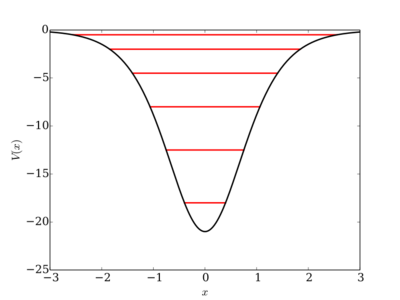Pöschl–Teller potential
In mathematical physics, a Pöschl–Teller potential, named after the physicists Herta Pöschl[1] (credited as G. Pöschl) and Edward Teller, is a special class of potentials for which the one-dimensional Schrödinger equation can be solved in terms of special functions.
Definition
In its symmetric form is explicitly given by[2]
- [math]\displaystyle{ V(x) =-\frac{\lambda(\lambda+1)}{2}\mathrm{sech}^2(x) }[/math]
and the solutions of the time-independent Schrödinger equation
- [math]\displaystyle{ -\frac{1}{2}\psi''(x)+ V(x)\psi(x)=E\psi(x) }[/math]
with this potential can be found by virtue of the substitution [math]\displaystyle{ u=\mathrm{tanh(x)} }[/math], which yields
- [math]\displaystyle{ \left[(1-u^2)\psi'(u)\right]'+\lambda(\lambda+1)\psi(u)+\frac{2E}{1-u^2}\psi(u)=0 }[/math].
Thus the solutions [math]\displaystyle{ \psi(u) }[/math] are just the Legendre functions [math]\displaystyle{ P_\lambda^\mu(\tanh(x)) }[/math] with [math]\displaystyle{ E=\frac{-\mu^2}{2} }[/math], and [math]\displaystyle{ \lambda=1, 2, 3\cdots }[/math], [math]\displaystyle{ \mu=1, 2, \cdots, \lambda-1, \lambda }[/math]. Moreover, eigenvalues and scattering data can be explicitly computed.[3] In the special case of integer [math]\displaystyle{ \lambda }[/math], the potential is reflectionless and such potentials also arise as the N-soliton solutions of the Korteweg–De Vries equation.[4]
The more general form of the potential is given by[2]
- [math]\displaystyle{ V(x) =-\frac{\lambda(\lambda+1)}{2}\mathrm{sech}^2(x) - \frac{\nu(\nu+1)}{2}\mathrm{csch}^2(x) . }[/math]
Rosen–Morse potential
A related potential is given by introducing an additional term:[5]
- [math]\displaystyle{ V(x) =-\frac{\lambda(\lambda+1)}{2}\mathrm{sech}^2(x) - g \tanh x. }[/math]
See also
References list
- ↑ ""Edward Teller Biographical Memoir." by Stephen B. Libby and Andrew M. Sessler, 2009 (published in Edward Teller Centennial Symposium: modern physics and the scientific legacy of Edward Teller, World Scientific, 2010.". https://e-reports-ext.llnl.gov/pdf/376159.pdf.
- ↑ 2.0 2.1 Pöschl, G.; Teller, E. (1933). "Bemerkungen zur Quantenmechanik des anharmonischen Oszillators". Zeitschrift für Physik 83 (3–4): 143–151. doi:10.1007/BF01331132. Bibcode: 1933ZPhy...83..143P.
- ↑ Siegfried Flügge Practical Quantum Mechanics (Springer, 1998)
- ↑ Lekner, John (2007). "Reflectionless eigenstates of the sech2 potential". American Journal of Physics 875 (12): 1151–1157. doi:10.1119/1.2787015. Bibcode: 2007AmJPh..75.1151L.
- ↑ Barut, A. O.; Inomata, A.; Wilson, R. (1987). "Algebraic treatment of second Poschl-Teller, Morse-Rosen and Eckart equations" (in en). Journal of Physics A: Mathematical and General 20 (13): 4083. doi:10.1088/0305-4470/20/13/017. ISSN 0305-4470. Bibcode: 1987JPhA...20.4083B. http://stacks.iop.org/0305-4470/20/i=13/a=017.
External links
 |


